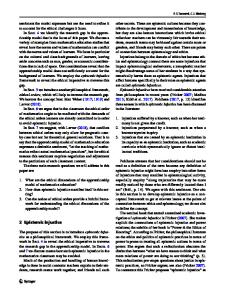Mathematics and Education: Collaboration in Practice
This chapter describes the work of a longstanding collaboration between a research mathematician and a practicing teacher and education researcher. In addition to showcasing specific aspects of the joint work, and the ideas that have been produced, the ch
- PDF / 237,344 Bytes
- 14 Pages / 441 x 666 pts Page_size
- 15 Downloads / 365 Views
Mathematics and Education: Collaboration in Practice Hyman Bass and Deborah Loewenberg Ball
Abstract This chapter describes the work of a longstanding collaboration between a research mathematician and a practicing teacher and education researcher. In addition to showcasing specific aspects of the joint work, and the ideas that have been produced, the chapter also examines the nature, challenges, and opportunities of this unusual cross-disciplinary collaboration. Keywords Collaboration · Mathematics instruction · Mathematical knowledge
Over the last 15 years, we have been studying the work of teaching mathematics in primary school classrooms (Ball 1999; Ball and Bass 2000a, 2000b, 2003a, 2003b, 2008, 2009; Bass 2005; Ball et al. 2005a, 2005b). Our goal, as research mathematician and education researcher, has been to understand what it takes to teach mathematics with integrity, and to contribute to the improvement of teachers’ training. We have asked: What is mathematical about mathematics teaching, and what are the mathematical demands of that work? We brought to this research complementary training, skills, knowledge, and perspectives. We studied primary records of practice so as to focus on common artifacts that we could examine, analyze, discuss, and unpack. These records— most often videotapes of lessons—also enabled us to hold teaching still, and to study and re-study the same moments, interactions, explanations, questions, and tasks. The perspective that we have developed is that mathematics teaching is a special form of mathematical practice—a form of applied mathematics (Bass 2005)—and it has been this frame that has both required our collaboration and supported its development. We will illustrate this with examples, showing both the affordances of our work together, as research mathematician and education researcher, and also its challenges and the problems we have had to solve.
H. Bass (B) · D.L. Ball University of Michigan, Ann Arbor, MI, USA e-mail: [email protected] M.N. Fried, T. Dreyfus (eds.), Mathematics & Mathematics Education: Searching for Common Ground, Advances in Mathematics Education, DOI 10.1007/978-94-007-7473-5_17, © Springer Science+Business Media Dordrecht 2014
299
300
H. Bass and D.L. Ball
Two premises guide our work: • Children are not learning mathematics nearly as well as they could, and should • Improving mathematics instruction and student learning depends on expertise both in disciplinary mathematics and in instruction Addressing these issues has been our driving purpose; what we have learned about collaboration is a by-product of our actual work together. We did not set out to study collaboration; our work demanded it. But that work taught us much about the entailments of collaboration. Our work together started in 1994, with a question from Ball to Bass: “What mathematics do you see in this episode of elementary teaching?” This exchange illustrates several characteristic features of our ongoing work. First, its motivation was to better understand the mathematical resourc
Data Loading...











